Lifestyle
Las Vegas' new must-see show plays with animation, dance and what it means to be human
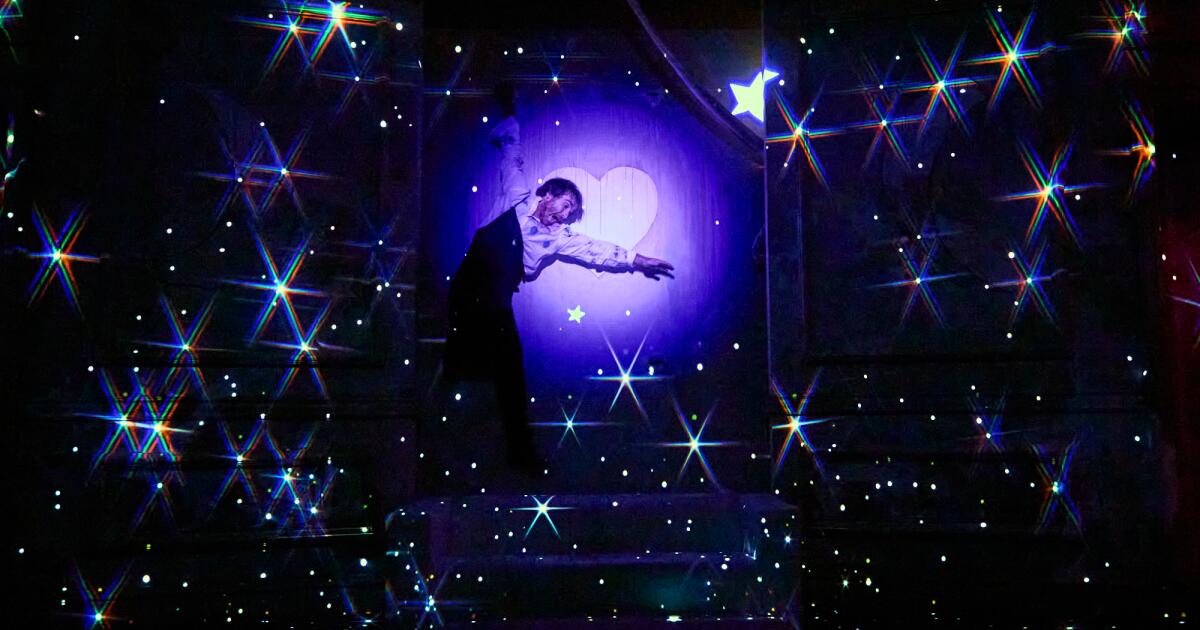
There are multiple dance duets in “Particle Ink: House of Shattered Prisms,” a mixed-media theatrical production that debuted last month on the Las Vegas Strip. They are highly acrobatic and borderline risqué — this is Vegas, after all — and they are also feats of wonder, for the dance partner is not another human but an animated character.
Particle is his name, and he’s a glowing white figure with a circular head and a rectangular body, a mix of simple shapes that can convey an array of human emotions via elastic, exaggerated movements. Animation, rooted in imagination, has long had the power to amplify human feelings and heighten reality. But in “Particle Ink,” animation enters our reality, as Particle, for instance, leaps from wall to pillow, dashes across a bed curtain and even cries into a physical bucket.
“I wish I was 3-D,” Particle scrawls at one point on the wall, but the show makes us believe that he is vaulting among us. Look into a mirror, and Particle sits and walks atop our heads, becoming essentially a virtual animated pet. At one point, a dancer contorts herself as she carries Particle, tucked in a birdcage, across a room. Actors appear to hold Particle’s hand, and Particle even does battle with metaphorical demons, his projected body bounding across a room and swirling in and out of a toilet bowl.
Animation, with “Particle Ink,” has entered its live-theater era. It’s doing so via an exploration-focused production, meaning guests wander from room to room following actors as the acts unfold — or, in the case of “Particle Ink,” guests may be trailing animated figures or a puppet.
Think of it, then, as a sort of next-generation “Sleep No More,” New York’s long-running immersive production that is set to close this year. Only here, the theme is an original fairy tale rather than “Macbeth,” one where animation and augmented reality tools are used to explore our inner world, bringing it to life on walls, floors and furnishings with whimsical, highly active drawings that appear born of light.
Created by an enigmatic three-person creative team known as the LightPoets, a group with roots in Las Vegas, “Particle Ink” dates to 2017, when a proof-of-concept installation was shown at the Sundance Film Festival. It caught the attention of entertainment industry vets Jennifer Tuft and Cassandra Rosenthal, who, with their mixed-reality company Kaleidoco, have been working to bring “Particle Ink” to life. The show had a brief run in 2022 in downtown Las Vegas, but pre-pandemic it was planned for New York, where Kaleidoco once had a 10-year lease on a five-story Manhattan building targeted for the show.
The character of Lilith (Dani Maloney) shares a dance with animated Particle on a bed in “Particle Ink: House of Shattered Prisms,” a new immersive show in Las Vegas.
(Particle Ink)
“We went big,” Tuft says, noting the group was about six weeks from loading when the COVID-19 lockdown began and altered the “Particle Ink” plans. Most of the initial costs proved to be recoupable or able to be redirected to a different space. “Particle Ink” now is committed to the Luxor Hotel & Casino for at least four years, residing in what used to be the hotel’s wedding chapel.
The inward-looking fantasy is set in multiple black-box rooms with minimalist furnishings — a communal, ritualistic hub, a library, a bathroom, a bedroom and a mini forest among them. The dancing is rigorous, with performers often seeming to be wrestling with themselves as they do battle with sometimes hidden (and sometimes not) existential demons. Fast-moving digital artwork comes alive on walls, much of it drawn via a wand, by a nameless artist, portrayed by Elenah Claudin, who serves as the show’s protagonist.
His rainbow-colored creations spring from a chest, and in one moment he turns a couch into a piano and in another sketches out a mystical horse and appears to gallop through his invented world. The images split the difference between something childlike and fanciful street art. Strategic use of projections among the sets allows the animation to appear tangible.
This merging of tech and animation into a believable landscape — what the LightPoets refer to as the “2.5 dimension” — is the triumph of “Particle Ink.” But it’s not the show’s heart. This is ultimately a story about loss, and searching to regain one’s footing after extreme grief. A black-lighted scribble on the wall in the show’s lobby spells it out: “Some of us are dead,” alluding to characters in the show that may live on only as memories or creative visions.
“It’s about everything from childhood wonderment to grief and loss, to really accepting yourself,” Tuft says. “It’s about striking a balance about reaching within and understanding oneself. These are concepts that don’t necessarily lend themselves to what people generally consider ‘Las Vegas entertainment.’”
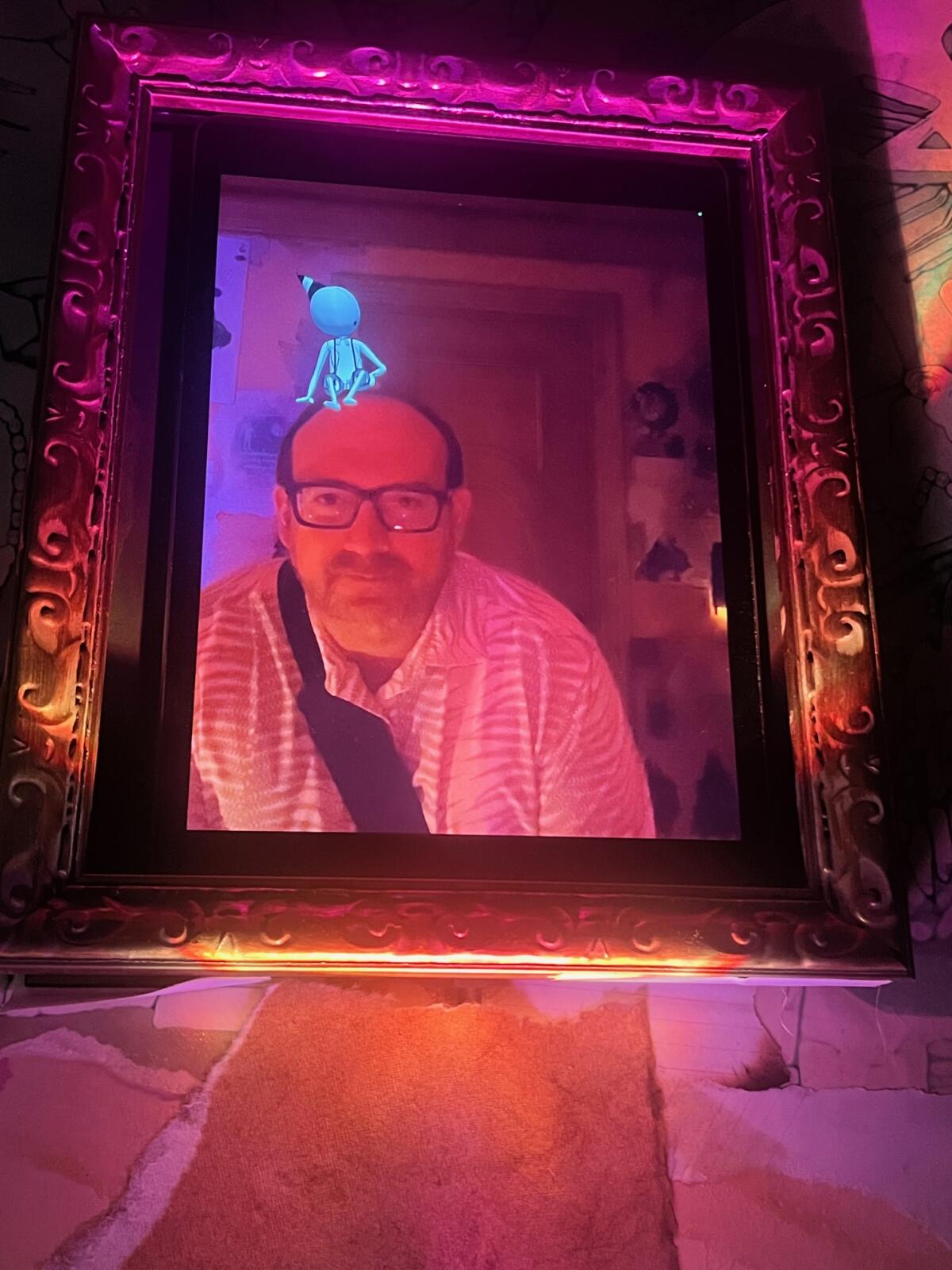
Times Game Critic Todd Martens interacts with the animated character of Particle in the new Las Vegas immersive show “Particle Ink: House of Shattered Prisms.”
(Todd Martens / Los Angeles Times)
And yet here it is, complete with nods to mysticism, as well as tarot and oracle art. “Particle Ink” ultimately strives to tell a personal narrative about the journey to regain one’s creativity, relying primarily on movement and animation to do so. There is little dialogue outside a wandering puppet, a sort of wise man who can exist between worlds (or fill in narrative gaps for those who choose to focus on one of the show’s touchscreen-like walls and handful of augmented reality devices that further the adventures of Particle and his pals).
“Particle Ink” is a story of heartbreak. It follows the artist, his partner, Lilith (Dani Maloney), and the world he conjures. It pulls from age-old tales of light and dark, and how our minds are factories of fascination but also places of imprisonment. It also wants to remix the theatrical experience, as it not only heavily relies on technology but also takes influences from the world of gaming. A projection of a sword being drawn emerges on a wall, and then it becomes a prop for a battle scene. Its narrative too is quest-based, a journey for Particle to recover pieces of his creator’s shattered heart.
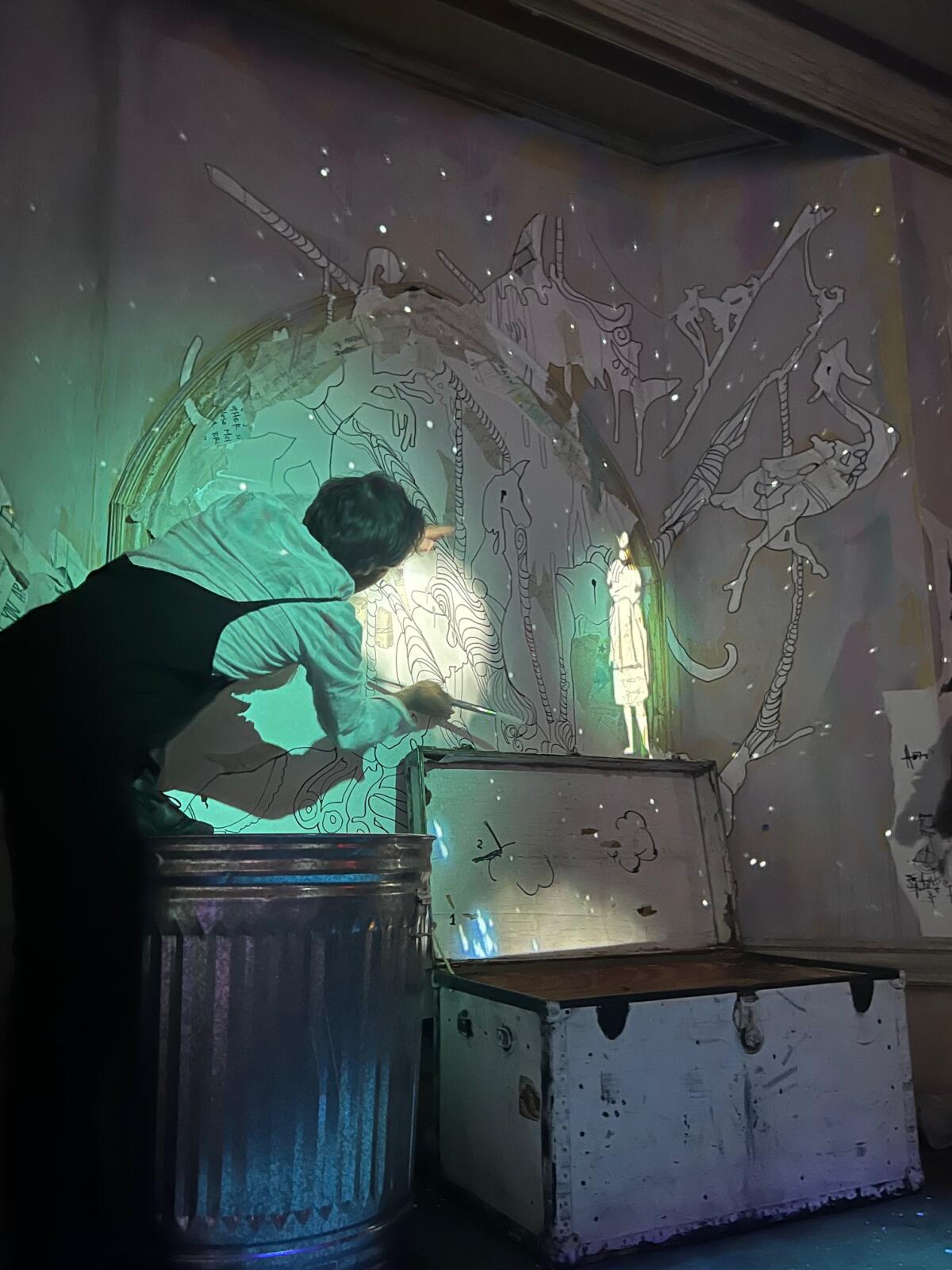
Animation comes alive via light and projections in “Particle Ink: House of Shattered Prisms,” a show that explores how an artist (Elenah Claudin) harnesses the power of creativity in overcoming grief and heartbreak.
(Todd Martens / Los Angeles Times)
Jo Cattell, a Chicago-based theater director and one third of the LightPoets, sometimes even intermingles the word “player” and “audience member,” noting that immersive theater only works if attendees quickly understand the rule-set of the creative work. While there’s no real onboarding in “Particle Ink,” the first scene builds to a communal ritual centered around light-gathering stones, one that allows our distressed artist to briefly tap into his creativity only to quickly lose it again. Particle, then, prods the audience on a journey of recovering his splintered heart.
I saw “Particle Ink” twice, the first night focusing heavily on interacting with the animation. Throughout the theatrical space are tablets that are reconfigured to look and feel like magic mirrors, further glimpses into the so-called 2.5 dimension. The second night, however, I decided to zero in on the narrative, and found both charm and anguish in the way Particle strives to heal his creator’s broken heart — Particle’s tiny size, playful nature and purposefully hand-drawn feel created a sense of fragility. Grief can be a stubborn place, but I felt moved in the way “Particle Ink” used creative tools — painting, creating and animation — to show how what we lose continues to live with us.
Thinking about the future of theater, Cattell wonders about today’s younger generations weaned on smartphones and games. While she says this isn’t a LightPoets thesis, she’s eager to experiment with ways to make theater a more active experience. The tradeoff is that the experience is less controlled, but those who go along for the ride can home in on certain characters or emotions. In theory, it creates a more personal show.
“I don’t want to call it a playground because I think that has connotations,” Cattell says. “But we definitely want people to play and create and have fun and enjoy, but at the same time watch something that might move them. Depending on who they are, or what moment of their life they’re in, it might break their heart.”
‘Particle Ink: House of Shattered Prisms’
Manifestations of grief and inner turmoil here emerge as giant characters outfitted as ink blots. The metaphor isn’t terribly difficult to uncover: With depression, and a loss of purpose, life is depleted of color. But it’s how the story is told that matters, and with a mix of animation and highly athletic dance, “Particle Ink” is 75 minutes of unexpected theatrical interactions. Cattell, for instance, estimates that there are about 10 hours of original animation, and creating a show in which performers would be interacting with walls and objects was a challenge.
“When you go to theater school, you don’t get taught to play with the walls,” Cattell says. “It’s been interesting coming from a theatrical background. We’re going to break rules. We’re breaking rules in storytelling, in genre and format. But there’s a reason those rules exist. How do we still make sure the performer is connecting with the audience when the performer is now turning away from the audience?”
The solution: Find a way for those wall-bound animated characters to break free. And then let them dance.

Lifestyle
Can you make music from Joshua trees — or is that wild science? Yes.

Artist Scott Kildall waves his microcontroller over a Joshua tree, recording wavelengths of light that are not perceptible by humans.
Carlos Jaramillo for NPR
hide caption
toggle caption
Carlos Jaramillo for NPR
The artist Scott Kildall is waving his hand over the contours of a Joshua tree, just inches from its spiky green, bayonet-like leaves.
“If I get too close to it, it will prick me and draw blood,” he says. “And it’s done that before.”
In his palm, he has a microcontroller — just about the size of a credit card. It’s got a few wires sticking out, and an infrared sensor, which picks up wavelengths of light just beyond what the human eye can perceive.
“It’s kind of like magic,” Kildall says. “And the magic is just revealing something that’s right beyond our levels of perception.”
The magic is part of Kildall’s latest sound installation — a work he calls Infrared Reflections. He developed the piece as an artist-in-residence at Joshua Tree National Park this spring, and it transforms near-infrared light bouncing off the iconic scraggly yuccas into a shimmering mosaic of otherworldly music — essentially turning the Joshua tree into an instrument.
Kildall is neither a computer scientist nor a musician, though he does play the ukulele. This artwork relies on both disciplines, as Kildall needs to build sensors, route their data to a computer, process and smooth that data, and convert it all into something beautiful for the ear.
“With art and technology, you have to constantly think about wearing multiple hats. Are you an IT person? Are you an artist? And you have to be able to troubleshoot on the fly,” he says.
The installation relies on a fundamental interplay between the sun and the Joshua tree. When sunlight hits the plant, cells in its healthy leaves soak up lots of red and blue light, and reflect back most of the green – which is why the clusters of piercing leaves at the end of the Joshua tree’s branches appear green to the human eye. (It’s also why most plants on Earth appear green to us.)

Spiky Joshua trees grow in Arthur B. Ripley Desert Woodland State Park, north of Los Angeles.
Carlos Jaramillo for NPR
hide caption
toggle caption
Carlos Jaramillo for NPR
But other types of light rain down on the Joshua tree too, including wavelengths we can’t see, like near-infrared light. The plant’s shaggy, grayish-brown bark doesn’t reflect much of that infrared light, but its healthy leaves — packed with compounds like water, carbohydrates and defense chemicals — reflect much more. And that’s exactly what Kildall sees as he passes his sensor from the yucca’s dead bark to its green, leafy buds.
“Beyond our perceptions lies a whole realm of invisible data,” he explains. “And so what I do is I find some sort of invisible phenomena such as water quality or air quality or infrared light reflection, and then map that data into sounds, so that we can hear that data.”
That technique is known as sonification, and Kildall has previously designed installations that sonify water flow in trees, or tap into the electrical signals of mushrooms. Infrared Reflections follows in that vein, but it’s much more site-specific — it’s meant to be played on the Joshua tree, which is endemic to the Mojave Desert.

Kildall needs a speaker and a bag of equipment on site to make his music.
Carlos Jaramillo for NPR
hide caption
toggle caption
Carlos Jaramillo for NPR
With that in mind, earlier today Kildall lugged his laptop, a box of electronics and a giant speaker into a field full of Joshua trees at the Arthur B. Ripley Desert Woodland State Park, north of Los Angeles.
Gusts of wind scream through the high desert here, and Kildall eyes individual Joshua trees with the eagerness of a kid at Guitar Center, ready to pick out an axe.
“I see one Joshua tree that’s about a hundred feet away that is moving a little bit in the wind and has multiple leafy sections and bark sections,” he says. “And that one really looks like it is asking to be sonified.”

Kildall’s speaker sits next to several Joshua trees.
Carlos Jaramillo for NPR
hide caption
toggle caption
Carlos Jaramillo for NPR
After a short walk, Kildall sets down the speaker and begins fiddling with his laptop. It’s perched on a camp chair, in direct sun, and refuses to boot up — a reminder, Kildall says, of how preparing for a field installation is like planning a NASA space mission (though with non-lethal stakes.)
“You want to reduce the number of points of failure. And so with the system I have, I have backup electronics, I only have one laptop. So that’s the only point of failure that I’m really worried about.”
But not to fear. The machine soon boots up, along with a local Wi-Fi network — which connects the small infrared sensor to the computer — and Kildall is ready to rock.

A view of Joshua trees at Arthur B. Ripley Desert Woodland State Park.
Carlos Jaramillo for NPR
hide caption
toggle caption
Carlos Jaramillo for NPR

Here’s the same landscape viewed through a thermal infrared camera. It captures a different part of the infrared spectrum from what Kildall is picking up with his sensor, but gives a sense of how these plants appear differently when viewed at different wavelengths of light.
Carlos Jaramillo for NPR
hide caption
toggle caption
Carlos Jaramillo for NPR
As he caresses the air just above the tree, the yowling of a theremin rises and falls from the speaker, lending an eerie soundtrack to the already alien-looking landscape. A few hikers walk by, but seem unphased by the guy performing reiki on a Joshua tree. The high desert is known for its eccentrics, after all.
Kildall has designed three more “instruments” to be played like this, along with the theremin sound.
His favorite combines the drone of a theremin with spiraling arpeggios.
Another sounds more like haunting electric guitars, reverberating in a cathedral.
The final sound is more pared-back and simple — resembling a kid plinking at the piano.
“In some ways, it feels a little bit more direct and accessible because we all kind of understand how to press notes randomly on the piano,” Kildall explains. “And as I move the sensor over these sort of leafy spots in the sun, those will produce a higher pitch on the piano.”
As he slides the sensor further down the branch, to the bark, the notes get lower and lower, moving deeper into the bass clef.
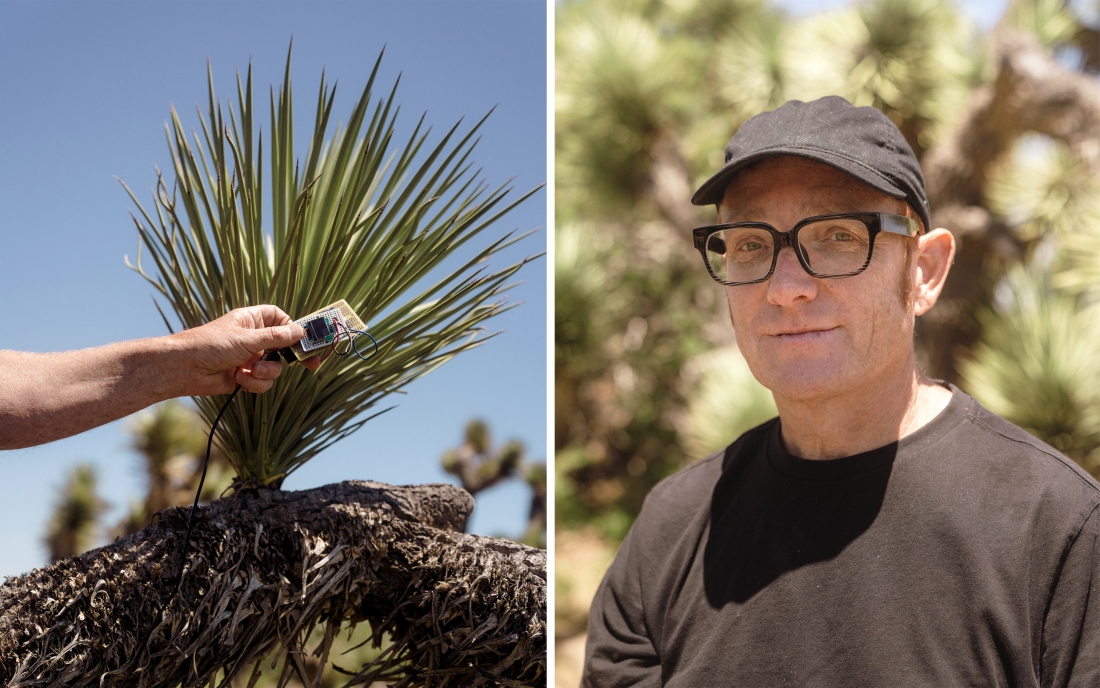
Kildall holds his device a few inches above a spiky Joshua tree to avoid getting pricked.
Carlos Jaramillo for NPR
hide caption
toggle caption
Carlos Jaramillo for NPR
It’s a fascinating way to make music. The infrared-sensing technology at the heart of the work also happens to be something scientists have employed for decades.
“From our aircraft or satellites, we use it to separate the living vegetation from the dead vegetation,” says Greg Asner of Arizona State University in Hawaii. “That’s very important in a grassland — is the grassland dry and ready to go up in smoke in a fire, or is it wet and green and living? And so we can translate that to fire fuel load for grasslands.”

Joshua trees viewed through a thermal infrared camera.
Carlos Jaramillo for NPR
hide caption
toggle caption
Carlos Jaramillo for NPR
Asner has also soared above the Amazon basin, measuring infrared signals from a plane — which allows him to tease out individual tree species, based on the fingerprints of infrared light that bounce off the trees.
“When I fly over a tropical rainforest with the infrared sensors, the maps literally are like Willy-Wonka-candy-store-style variation. They are amazing to look at,” he says.
“So there’s this enormous diversity of plants when you look at them in infrared light. And unfortunately, a lot of people just see them as green because that’s all we can see with our limited eyesight. There’s much more variety out there. And it’s a very beautiful world when you look at it in the infrared.”
Asner says he’s thrilled to see artists now experimenting with the same technology.

Left: A close up view of a Joshua tree. Right: A thermal infrared view of Kildall holding his device in front of a Joshua tree.
Carlos Jaramillo for NPR
hide caption
toggle caption
Carlos Jaramillo for NPR
“Our studies for decades now have been stuck in the halls of science. And this will help translate what we have come to understand, utilize, love as scientists — it’s going to translate it to a much wider audience.”
Kildall says, in some sense, that’s his goal.
“One of the things I like to do is to engage people with nature and issues of climate change and issues of ecology through means other than science articles,” he says. “Science articles are great. I read them all the time. However, they don’t engage people on a more visceral storytelling level, as artwork does.”
And though this installation was conceived and developed with the Joshua tree at its center, it could work with the infrared reflections of other plants, if Kildall calibrates his code — which is a good thing, since Kildall calls San Francisco home.
“There aren’t any Joshua trees in San Francisco, so I might have to go to Golden Gate Park and see what I come up with.”
Lifestyle
They cut their water bill by 90% and still have a 'showstopping' L.A. garden

Water-hungry lawns are symbols of Los Angeles’ past. In this series, we spotlight yards with alternative, low-water landscaping built for the future.
Looking out the front windows of their northeast L.A. home, Kyle Anido and Katie Cordeal say their front yard is barely recognizable from a year ago when it was a lawn.
“It’s crazy to see how lively the garden is now,” says Anido, a 37-year-old camera operator. “There is so much bee activity.”
A bee is drawn to the Bird’s-Eye Gilia in Katie Cordeal and Kyle Anido’s front yard.
“It has absolutely exploded,” adds Cordeal, 38. “It’s pretty incredible what has happened over the past 12 months. And we haven’t even watered the yard this year.”
The colorful ecosystem, which thrives without sprinklers, amendments, fertilizers, gardeners and gas-powered lawn equipment, is not lost on the couple’s 2½-year-old son, Owen.
“Bees!” he yelled with delight from the front porch, pointing to the pollinators feeding on the native California flowers in his front yard.
“Owen loves bugs,” Anido says of the boy’s vibrant playground.
When the couple purchased their first home in 2021, the front yard was an uninspired swath of Bermuda grass, an oddly placed palm that real estate agents hastily planted for staging purposes and white gravel.
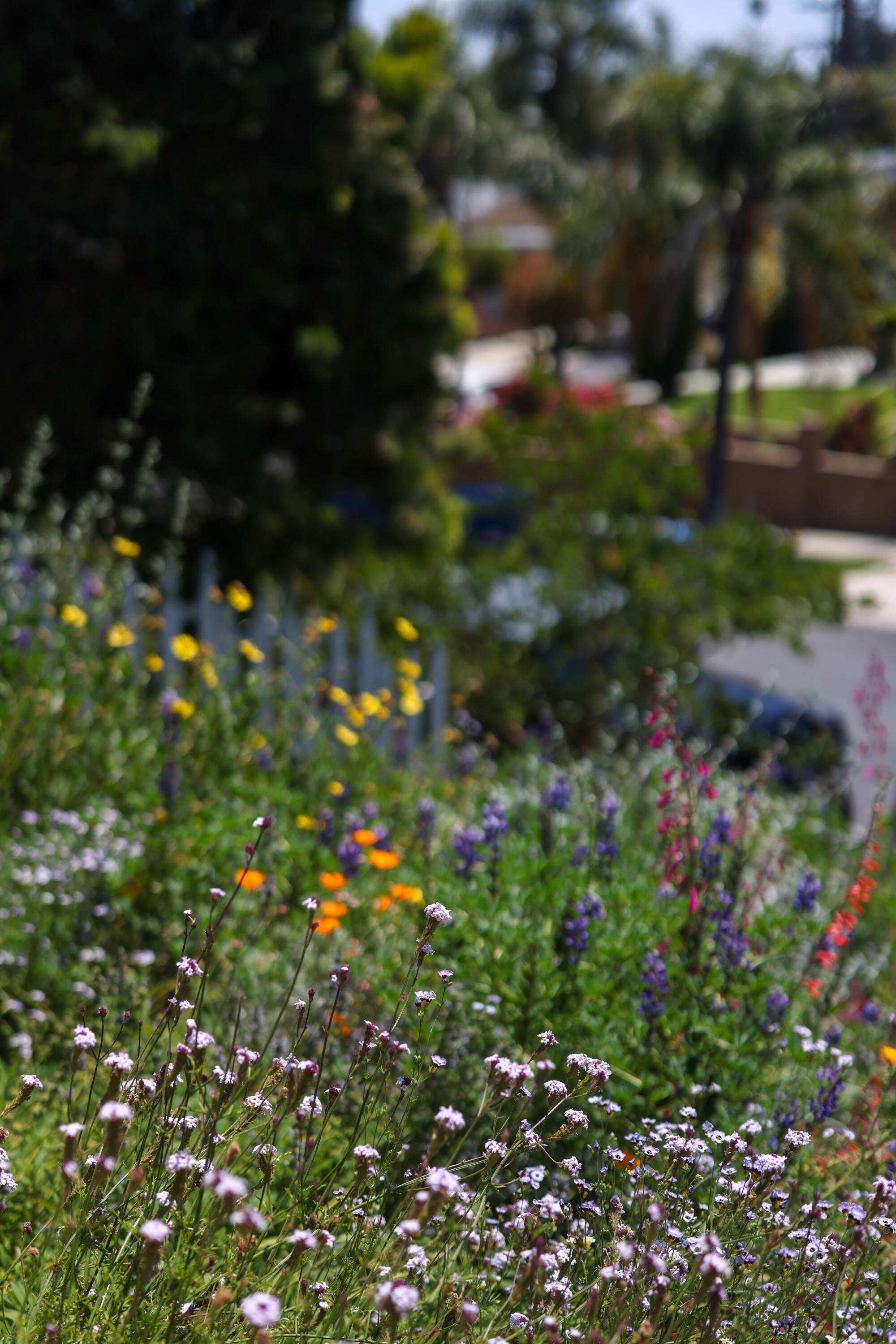
Homeowners Katie Cordeal and Kyle Anido wanted a colorful, drought-tolerant landscape.
(Dania Maxwell/Los Angeles Times)
After renting an apartment in Brooklyn, the couple felt intimidated by the prospect of caring for a home and yard and decided to keep the previous owners’ gardener. They did this, they say, because it was easy, but the noise and environmental pollution from the weekly “mow and blow” proved difficult for Cordeal, who works from home as a film and television production accountant.
“We would have to close all the doors and windows because the gas-powered leaf blower was so loud,” she says. “I hated the gas smell.”
Interested in conservation and drought-tolerant plants, the couple contacted garden designer Sophie Pennes of Urban Farms L.A. after viewing her before-and-after turf transformations — and lawn rants — on TikTok.
“I identified with what seems to be Sophie’s primary drivers — to support biodiversity, revitalize natural ecosystems, and conserve water,” Cordeal says. “Also, I could tell she is educated and passionate about what she does, and I enjoyed her dry humor.”
While this year’s record-setting rainfall may feel like an excuse to reconsider the argument for removing thirsty turf, that’s ludicrous, says Pennes, who specializes in edible gardens and California native gardens.
“Tearing out your lawn is about so much more than saving water,” the landscape designer says. “You don’t need to be a scientist to see the negative impact of lawns on the native habitat in any given city or ecology. It’s obvious when you’re walking through a neighborhood, and you stand in front of a grass lawn, and then you stand in front of a native garden: you can see the wildlife. We need to engage in the places where we live.”
Before and after photos courtesy of Katie Cordeal.

Mexican marigolds repel pests and attract birds.
After agreeing on a plant palette that included lots of color, wistfulness, texture and tall grasses, the couple hired a landscape contractor to remove their lawn by hand. They then sheet mulched the front yard — smothering it in wet cardboard — and waited for three months.
When it was time to plant, Pennes installed repeat groupings of three, including ceanothus, Canyon Prince Wild Rye and penstemon. “I wanted to have a bold effect when things were in bloom,” she says of the homeowners’ request for a colorful landscape. “I didn’t want it to be casual; I wanted it to be showstopping.”
A year later, the front yard is what they had hoped for. From the street, the 1937 residence appears modest, a two-bedroom house with two large picture windows. But the garden is indeed a showstopper. “It is such a magical walk to the front door,” Cordeal says of the lupine, poppies, penstemon and sage blooming on either side of the stairs up to the house.
Pennes designed the garden so that something is always in bloom regardless of the season. The purple Showy Penstemon is starting to fade, for instance, but the clarkia flowers are ready to open. On the parking strip, Hollyleaf Cherry and hardy Canyon Prince Wild Rye counter the pink clarkias and California bluebells. “Canyon Prince Wild rye has such a beautiful gray-green color that pops against the backdrop of the gray house,” Pennes notes.
Non-native plants include African Basil, “which the bees love,” Cordeal says, as well as Meyer lemon and Hass avocado trees, which the couple feed with water from their bathtub through a graywater system installed by Greywater Corp. Pennes also planted Mexican marigold to help repel pests and attract wildlife. “The finches love it,” Pennes says. “As soon as you put the plants in, the butterflies and birds find them. It really is an ‘if you build it, they will come,’” she laughs.
The couple estimates they paid around $14,900 for the transformation, including the design, labor, plants, trees and mulch. After removing 1,150-square-feet of lawn in the front yard and the parking strip, their $5,750 turf replacement rebate from the Department of Water and Power brought the total down to $9,150. Over the past year, the couple also saw their water bill decrease by 90%. “Our June/July 2022 water bill was $210.99,” says Cordeal. Their bill for June/July 2023 water was $24.28, including the extra water used to establish the 1-gallon plants.
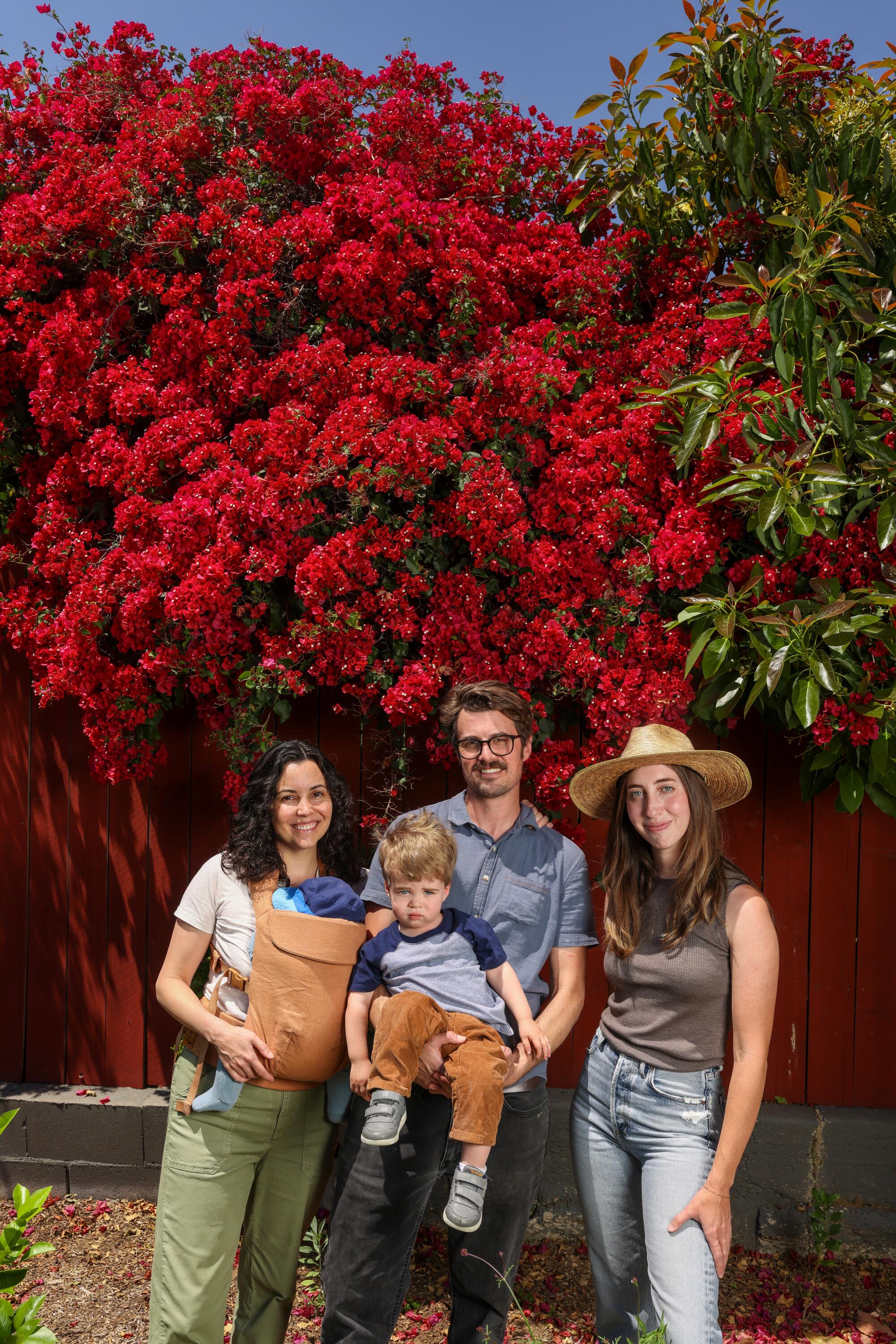
Homeowners Katie Cordeal and Kyle Anido with their newborn Felix, toddler Owen and Sophie Pennes of Urban Farms L.A., right, who helped landscape the yard.
But they are not stopping there. They are in preliminary talks with Pennes to overhaul their excessively hot backyard.
“We want to remove most of the concrete,” says Cordeal. “We want a veggie garden and another fruit tree that can use graywater. We want a lot more foliage in general to cool the backyard. We also need to figure out lots of play space for our two boys, but we’re not sure what ground cover that will be.”
You can be sure it won’t be artificial turf.
“My biggest enemy is plastic turf,” Pennes says. “Even if I get the opportunity to tear it out, it ends up being plastic garbage in a landfill.”
Cordeal says the beauty of the garden is more than just visual.
“Our front yard is an environmentally friendly site,” she says. “It’s so nice to look outside and see all the color and wildlife. I have a chair right by our front window, and when I’m nursing my 3-month-old, I can stare outside instead of at my phone. It’s a joy.”
Lifestyle
Is it time to re-name “summer?” Plus, prom fashion is all grown up : It's Been a Minute

Two students dancing at prom. Sinking sun during the 2022 California wildfires.
David McNew/AFP; Mario Tama/Getty Images
hide caption
toggle caption
David McNew/AFP; Mario Tama/Getty Images

Two students dancing at prom. Sinking sun during the 2022 California wildfires.
David McNew/AFP; Mario Tama/Getty Images
Summer is supposed to be for vacation and more relaxation, right? Well, for climate watchers, this season goes by a more sinister name. Brittany and NPR climate correspondents Lauren Sommer and Nate Rott get into what changes in summer weather mean for how and where we live.
Then, it’s prom season and high schoolers are showing out! But styles have changed since the days of poofy dresses and bedazzled purses: prom fashion has reportedly become more adult. For many young people, prom reflects their ideas of glamour, so does this shift say something new about the fantasies of girlhood? Brittany sits down with writer Hilary George-Parkin who wrote about the blurring of age in fashion.
This episode was produced by Barton Girdwood and Liam McBain with additional support from Alexis Williams. It was edited by Jessica Placzek and Sara Sarasohn. Engineering support came from Kewsi Lee. We had fact-checking support from Zazil Davis Vazquez. Our executive producer is Veralyn Williams. Our VP of programming is Yolanda Sangweni.
-

 News1 week ago
News1 week agoRead the I.C.J. Ruling on Israel’s Rafah Offensive
-

 World1 week ago
World1 week agoHoping to pave pathway to peace, Norway to recognise Palestinian statehood
-

 News1 week ago
News1 week agoLegendary U.S. World War II submarine located 3,000 feet underwater off the Philippines
-

 World1 week ago
World1 week agoFamilies of Uvalde school shooting victims sue Microsoft, Meta and gunmaker
-

 Politics1 week ago
Politics1 week agoDefense Secretary Lloyd Austin to undergo nonsurgical procedure, Deputy Kathleen Hicks will assume control
-

 Politics1 week ago
Politics1 week agoHunter Biden attends pre-trial hearing in Delaware court on federal gun charges
-

 News1 week ago
News1 week agoHere are three possible outcomes in the Trump hush money trial : Consider This from NPR
-

 News1 week ago
News1 week agoPrimate remains on the loose in South Carolina | CNN















